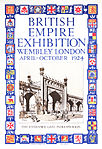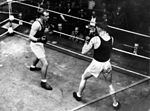Statue of Bobby Moore, Wembley

The Bobby Moore statue is a bronze sculpture of the former West Ham and England footballer Bobby Moore, situated directly outside England's national stadium, Wembley Stadium, in Wembley Park, north-west London. It commemorates the life of Moore, who captained the only England side ever to win the World Cup, defeating Germany 4–2 in the 1966 FIFA World Cup Final held in England at the old Wembley Stadium, demolished in 2003. Commissioned by the Football Association, it was unveiled outside the new stadium when it opened in 2007, fourteen years after Moore's death from cancer, aged 51. Standing 20 feet (6.1 m) tall on a stone plinth, it looks out over spectators as they walk down Wembley Way into the stadium. Sculpted by the Royal Sculptor Philip Jackson, it is Jackson's second piece featuring Moore, after the World Cup Sculpture unveiled in 2003.
Excerpt from the Wikipedia article Statue of Bobby Moore, Wembley (License: CC BY-SA 3.0, Authors, Images).Statue of Bobby Moore, Wembley
Atlantic Crescent, London
Geographical coordinates (GPS) Address Nearby Places Show on map
Geographical coordinates (GPS)
| Latitude | Longitude |
|---|---|
| N 51.5573 ° | E -0.2796 ° |
Address
Wembley Stadium
Atlantic Crescent
HA9 0PQ London (London Borough of Brent)
England, United Kingdom
Open on Google Maps





